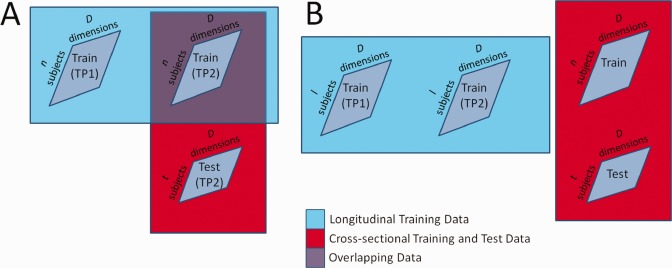Figure 1.

Illustration of Within‐Set Prediction and Information Transferring Prediction problems. Illustration of longitudinal and cross‐sectional data used in the Within‐Set Prediction (Panel A) and Information Transferring Prediction (Panel B) problems when there is data from two time‐points (TP1 and TP2). Panel A depicts the Within‐Set Prediction problem of predicting disease state at a follow‐up time‐point (TP2) using longitudinal information from both time‐points. In this case, the longitudinal training subject set (data in blue) matches the classification training subject set (data in the top part of the red area), with overlapping data shown in purple. To form the proposed features as in Eq. (2), the cross‐sectional training data (in purple) and test data (non‐overlapping area in red) is projected onto a subspace formed using the longitudinal training data (blue area). Graphic B depicts the Information Transferring Prediction problem, where the longitudinal subject set and classification subject sets are disjoint. In this case, there is no overlap in data between the longitudinal data (blue area) used to form the subspace in Eq. (2) and the classification data (both training and test data, red area) being projected. Here, the cross‐sectional data may come from a baseline or follow‐up time‐point.
